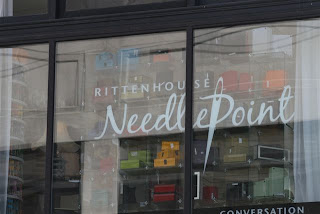
We were asked last weekend to come up with a stitch guide for the canvas at left. It was the first such request that we have received and I was glad for it as creating a custom stitch guide is perhaps the most fun one can have in a needlepoint shop with your clothes on!
Matching stitch to fiber to project in such a way as to enhance the original design and challenge but not overwhelm the stitcher is an art. What do I mean when I say that? Well, just that it takes skill, knowledge and finesse. No two will be the same. My suggestions will differ from Nancy's and both of our suggestions will vary depending upon the individual requesting the guide. The end result? Hopefully a uniquely beautiful piece of craftsmanship that will last and be appreciated for generations.

There are of course tools that one can use when developing a stitch guide. An extensive library of needlepoint-related books is absolutely necessary. Some needlepoint books have suggestions for how a particular stitch can be used. One series, the "Stitches for Effect" books, even include what they call the "effect index" which refers one to particular stitches when in search of certain effects (such as clouds, sky, water, etc.) The suggestions are not, like most suggestions, all to my liking but it's a place to start.
Another place to start is a picture book or a guide to needlepoint stitches that includes illustrations of the finished stitches. This is helpful in identifying stitches that have the look that you are hoping to achieve. Again, the stitches may or may not be appropriate (some may be too difficult, require a lot of compensation or a different type of fiber, etc.) but again it is a place to start.
At Rittenhouse Needlepoint we are building a library of needlepoint stitches as a byproduct of our Stitch of the Week class. Swatches from each week's stitch are available along with notes and a handout relating to the stitch. We've just started our second volume but eventually the library is likely to be quite extensive. For now, we keep the binders behind the checkout counter so if you would like to take a peek just ask we would be happy to show it to you.
Of course, the greatest resource for developing a stitch guide is experience -- long, hard-won experience. This takes time though I suspect that you probably already know more than you think you do and take heart too in the knowledge that not every canvas is suitable for decorative stitching and that in even the most complex of canvases basketweave is always a welcome respite.
PS -- Sorry about the first photo appearing sideways -- I tried to "fix" it (meaning I tried to get it to appear as it does in the original photo that I uploaded). However, every time I upload it, the blogger software insists on turning it on its side -- very frustrating. I tried to fix it for you but you know life is short and the day is young and blah blah blah -- you get the idea. S.





























